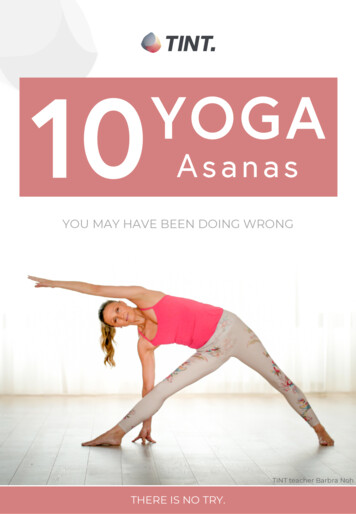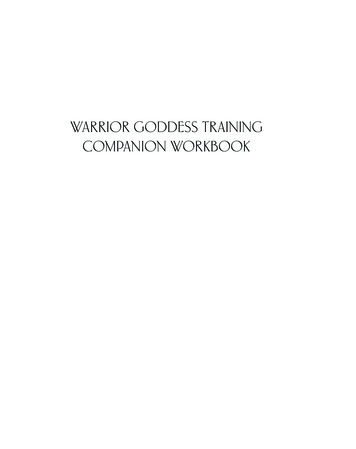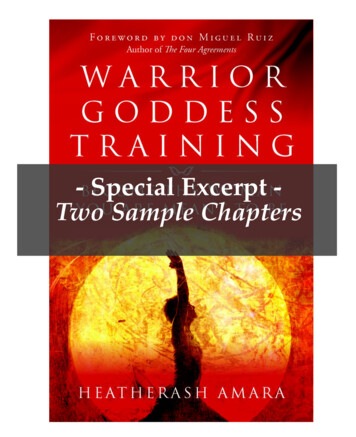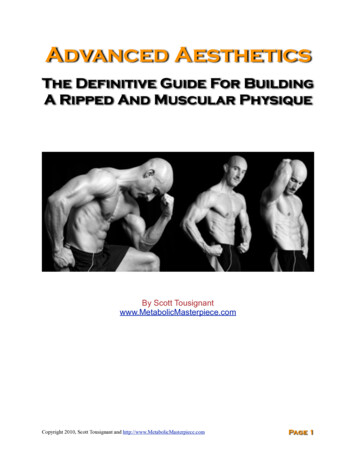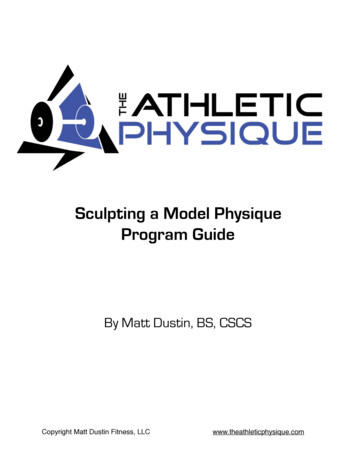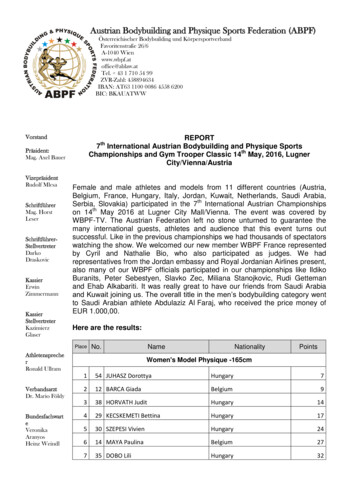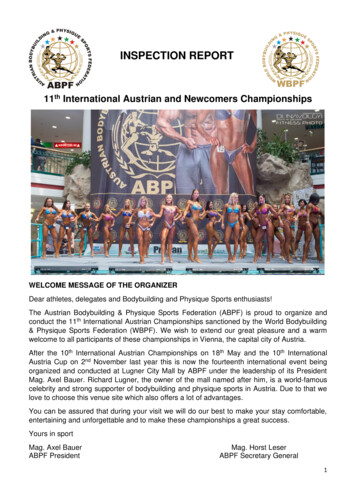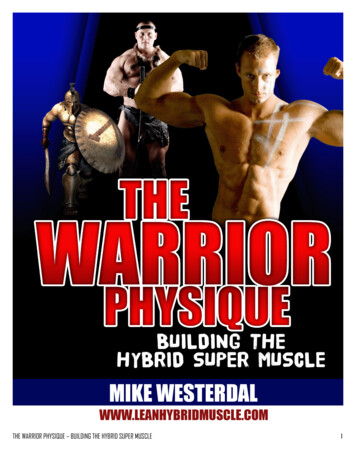
Transcription
THE WARRIOR PHYSIQUE – BUILDING THE HYBRID SUPER MUSCLE1
LEGAL STUFF 2009 Mike WesterdalAll Rights Reserved. International Copyrightwww.LeanHybridMuscle.comYou are welcome to share this Special report with others. You may NOT,however, edit it, extract from it, change the contents or offer it for sale in anyway shape or form. Trust me. It’s not worth the felony charges, fines, possibleprison time and bad charma.NOTICEThe information presented is not intended for the treatment or prevention ofdisease, nor a substitute for medical treatment, nor as an alternative to medicaladvice.This publication is presented for information purposes, to increase the publicknowledge of developments in the field of strength and conditioning. Theprogram outlined herein should not be adopted without a consultation with yourhealth professional.Use of the information provided is at the sole choice and risk of the reader. Youmust get your physician’s approval before beginning this or any other exerciseprogram.THE WARRIOR PHYSIQUE – BUILDING THE HYBRID SUPER MUSCLE2
WHY I WROTE THIS SPECIAL REPORTLike many of you I played sports in high school. I walked on the footballteam in college and played four years of football. Keeping my body lean andstrong during that period of my life wasn’t a problem. After all we had practice,mandatory weight lifting sessions, morning running and a very positiveenvironment for keeping the body in an overall anabolic state.As the post-college years kept passing by, I found myself being less andless active. Don’t get me wrong I found a new passion and started testing mymerit in amateur powerlifting over the past few years and it has kept me reallymotivated and I do love the competition. But something is missing. I’vegotten a lot stronger but I also gained over 25 lbs! It’s kind of embarrassingactually. Here I am preaching on the Internet and trying to help others stay fitand I go right ahead and pack on some un-needed pounds.What does all this have to do with the Warrior Physique Mike? I’m gladyou asked, let me explain. I have lot of relatives that live in Sweden and I’vealways been interested in Viking History. As I was reading a book of minecalled, “The Long Ships” I realized the Vikings didn’t have to workout in gyms,their lives and their battles were workouts enough. Fortunately I don’t have toengage in battle which is good considering I get winded from playing a pickupgame of basketball! It was starting to get obvious that I’d probably make alousy Viking and was nowhere close to the top shape I was in during college.Several months ago I hooked up with my now good friend Elliottt Hulsewho is the owner of a warehouse gym in my area called Strength Camp. Elliottis pro strongman and I started watching some of the workouts he was puttinghis clients through. This wasn’t like anything I had really seen before. Theyweren’t using your typical gym equipment. They were carrying odd objects,loading sandbags, dragging sleds and doing all kinds of exercises that lookedlike half resistance training and half cardio training.I told Elliott I wanted to try some of the “Warrior Training” methods. Hegrinned and wanted to know what I meant by that and I told him, that the guysfrom his camp train like guys from my Viking book. It’s no surprise Elliott and Ihit it off right away and started doing some workouts together.We’d combine my strength building exercises with his max effortresistance cardio techniques to come up with some pretty sick trainingsessions. The fat has been melting off and I’m still getting stronger so I thinkit’s safe to say we’re on the brink of discovering something pretty special.THE WARRIOR PHYSIQUE – BUILDING THE HYBRID SUPER MUSCLE3
In this report let us explore how some of this planet’s all-time greatestelite warriors of the past developed some physiques that have becomelegendary! If you feel like you’re close to becoming a desk jockey or you wantto feel like you did in college, revive your energy, build lean muscle mass whileburning fat as fast as possible than read on my friend!INTRODUCTIONIt’s no secret that our ancestors were physically, in much better shapethan overall, we are today. For ordinary people, their day-to-day lives weremuch more physically demanding than ours. Back in the day if you wanted toeat you had to go hunting or catch some fish. Everything was functional. Intoday’s world most of us are subject to the triple seated threat as I like to callit—sitting at our computers, sitting in the car or sitting on the couch.Let’s take a look back at our ancestors. Even without the medicine andadvancements in technology they knew how to develop muscle and they did itout of necessity not for aesthetics. It may just be we have a thing or two to learnand why coming full circle in our training may be just what we need. Let’s takea closer look at some of the elite warriors of the past.THE WARRIOR PHYSIQUE – BUILDING THE HYBRID SUPER MUSCLE4
Ancient cultures like the Spartans, Romans and the Scandinavians—often referred to as warrior cultures—had legions of career warriors whose solejob was to fight. This of course, required them to be in peak physical conditionand even more important, their fighting ability depended on compoundmovements.Legendary warriors of the past didn’t have gyms and machines to isolatetheir muscles. They didn’t train the chest one day, legs the next and back theday after that. There were no seated benches and workout devices that took allyour stabilizers out of the movement. Though they didn’t workout for looksalone, their training and the way they lived produced just that. The physiquesthat most guys strive for—yet very few ever achieve—were not the goal, butrather a byproduct of their lifestyles and how they trained to be warriors.We can’t relate to it today but these guys trained as though their verylives depended on it, because it did. It wasn’t just about losing a competition itwas about surviving to fight another day. They knew from experience that inorder to win battles—most of which were fought in hand-to-hand combat—theyhad to develop their entire bodies, not just certain parts. In other words, theyweren’t so interested in training the “beach” muscles like most guys are today.Rather, they were concentrating on developing their functional muscles andskills—the ones that would help them win the battle.You see though that their training routines wouldn’t have looked anythinglike what you see in gyms today—mostly machine- or apparatus-assistedTHE WARRIOR PHYSIQUE – BUILDING THE HYBRID SUPER MUSCLE5
movements that isolate particular muscles. No sir. Everything they did to trainwould have resembled “real-world” situations that they faced on any given day,which means lots of compound movements that simultaneously recruit anumber of different muscle groups.It’s because of this type of training—combined with the overall warriorculture in which these guys lived—that warriors like the Spartans, the RomanGladiators and the Vikings were consistently victorious in battle.VIKING WARRIORSWhen people talk about ancient warriors renowned for their physicalprowess, other than the Spartans of ancient Greece, the Viking warriors areamong the most likely to be discussed. And why is this? Because for 300 yearsthey kicked ass like nobody else. Like the Spartans, the Vikings were careerTHE WARRIOR PHYSIQUE – BUILDING THE HYBRID SUPER MUSCLE6
warriors, well-known for their superior hand-to-hand combat skills. Theytypically wore minimal body armor, instead relying on brute force and strengthcombined with agility and speed for protection. Their typical weapon of choicewas the battle axe, though they sometimes used swords as well.The Viking warriors were renowned for their ferocity in battle. In fact, theywere so fierce—and their reputation so frightening—that often times, theirvictims gave up without a fight. You’ve heard the term “berserk,” right? Well, itoriginated with the Vikings. Originally, it referred to a Viking class of warriorknown as the Berserkers. These guys wore coats of wolf or bear skin—noarmor here—and were reported to have fought in an almost uncontrollable rageor “trance of fury.”Why were the Viking warriors able to kick the collective asses of justabout every other culture they encountered for about 300 years? The answerlies in their training. Like I said, they were fierce, career warriors with onemission—conquer or be conquered. Their training regimen reflected thatintensity.First, the Vikings were mostly seafaring warriors traveling in boats, whichwere mostly propelled by physical manpower—or in other words, guys rowingwith oars. And since their typical “M.O.” was a rapid, surprise attack, there wasno time for rest. So after rowing for long distances, they would immediatelydisembark, get into formation, march for miles and then launch into a fiercehand-to-hand battle.THE WARRIOR PHYSIQUE – BUILDING THE HYBRID SUPER MUSCLE7
Each of these activities requires its own unique skill set. For example,rowing requires both strength and endurance while hand-to-hand combatrequires power, speed and agility. In order to be able to handle the demands ofall the things they were required to do on any given day, an ordinary trainingregimen just wouldn’t do. Even a cross-training routine wouldn’t be enough toget them into the peak physical condition their profession demanded. Nearlyevery physical exercise they did—whether it was just for training or duringbattle—required both physical strength and endurance.So instead of just running long distances, the Vikings would run longdistances dressed for battle and carrying their weapons along with their othergear. And that was just the warm-up. Afterwards, the real training would begin.THE WARRIOR PHYSIQUE – BUILDING THE HYBRID SUPER MUSCLE8
Remember, the lives of these guys had one purpose—fight to win. No day jobsand no weekends off. Their very lives were dependent upon their physicalcondition and their ability to fight so you know that when they trained, theytrained hard. Also, because of the variety of muscles and skills needed to dothe things they did, nearly all of their training routines would have involvedcompound/functional movements that recruited multiple muscle groups.Looking back at the types of activities Vikings engaged in on a regularbasis—rowing long distances, marching in full battle gear and hand-to-handcombat—we can imagine some of the things that they would do to getthemselves into the physical condition they needed to be in. So besidesmarching and running dressed for battle some of the things they did to developboth physical strength and endurance probably included: A variety of movements in which heavy objects would be repeatedlypicked up and lifted over the head. This would have bothstrengthened the core muscles and also built up endurance; Swinging a battle axe overhead in a movement that mimickedcrushing a foe’s skull (probably using hay or something as a target).Swinging and slamming the heavy battle axe into a target would havedeveloped upper body strength, endurance and accuracy;THE WARRIOR PHYSIQUE – BUILDING THE HYBRID SUPER MUSCLE9
Lifting, carrying and dragging heavy objects across distances. Thiswould have prepared them for any number of situations that theymight encounter—fallen trees or boulders blocking the trail, haulinggear and supplies or carrying the wounded;These are just a few examples of some of the things they would havedone to get in shape and prepare for battle. You can see that all of theseroutines are designed for functionality—to enable them to perform andTHE WARRIOR PHYSIQUE – BUILDING THE HYBRID SUPER MUSCLE10
ultimately, win the battle. They weren’t exercising so that they could look goodwhile hanging out at the beach, which is not what you see going on at mostgyms today.SPARTAN WARRIORSWe just talked about the Vikings so let’s take a look at their Greciancounterparts—the mighty, renowned Spartans. Though the Spartans were wellknown for their physical abilities long before the film 300 was ever envisioned,the movie put these ancient warriors in the spotlight once again—not onlybecause of their capacity to fight like no other, but also because of theirincredible training routines, which usually began at about the time a boy turnedseven years old.At that age, boys were typically taken away from their mothers and theywere moved into sort of Spartan youth training camps where the boys began todevelop their skills. This rigorous training program was known as the agoge.THE WARRIOR PHYSIQUE – BUILDING THE HYBRID SUPER MUSCLE11
The boys stayed there until they were about 20 years old. Right from the startthey focused on developing their physical strength and endurance. The brutaltraining programs were intended to develop physical strength, military prowess,communal bonds, discipline and obedience. The youngsters engaged in a widevariety of intense physical activities such as vigorous wrestling matches—usually with boys older and more skilled—and numerous track and field events.At the age of 12 the boys were thrown out into the elements to survive ontheir own. After a year, those who survived entered an even more rigoroustraining period, which consisted primarily of wargames and hand-to-handcombat exercises. These were very serious activities—not at all like the “mock”wargames we see today—in which contestants were often seriously injured oreven killed. Tough stuff yes, but Spartans were in the game to win. They hadTHE WARRIOR PHYSIQUE – BUILDING THE HYBRID SUPER MUSCLE12
one purpose in life—to fight and to protect Sparta and for that they were willingto train to any lengths to achieve that objective.Their training routines were focused on developing athleticism andfighting skills that were superior to the enemy. To develop these skills andenhance their adaptability, they trained using a variety of ever-changingroutines that incorporated compound movements. They also would have doneexercises that involved a great deal of lifting and throwing that incorporatedtheir weapons as well as heavy objects such as boulders and sacks of grain.The same session was rarely repeated.The overall point of these super intense regimens was to improve their“functional” or all-around fitness using a wide variety of movements thatdeveloped the skills, muscles and ranges of motion required in real fighting.They accomplished this by submitting the body to ever-changing—andincreasingly difficult—physical challenges.So you can see that even if “modern” gyms had been around back in thetime of the Spartans, a typical routine that you see in most of the fitnessmagazines would have done these guys little—if any—good. They might havelooked like they were in good shape and physically fit but on the battlefield, theywould have quickly gotten their collective asses kicked by their enemies andthey would have faded off anonymously into history rather than being known forthe legendary warriors they were.THE WARRIOR PHYSIQUE – BUILDING THE HYBRID SUPER MUSCLE13
When the directors of the movie 300 were planning production, theydecided that they wanted the actors to really look like authentic Spartanwarriors.The guys from the movie 300 were ripped and strong. But they had to train in acertain manner to get that way and it’s very similar to how the real Spartanstrained. The training routines they used were specifically designed to mimic thetraining routines that the actual Spartan warriors would have used in ancienttimes. In fact, their training regimen got almost as much attention as the movie.We’ll give you a routine so hang on.GLADIATOR TRAINING & COMBATScandinavia had its Vikings—we looked at them and their trainingroutines. Greece had the Spartans—we’ve looked at them too, so now let’smove over to Rome and take a look at the Gladiators. Like their brothers inGreece and Scandinavia, the Roman Gladiators were fierce fighters, highlyTHE WARRIOR PHYSIQUE – BUILDING THE HYBRID SUPER MUSCLE14
skilled in hand-to-hand combat techniques that demanded peak physicalcondition—strength, power, speed and agility.So like their warrior brethren to the north and the west, the Gladiatorsdidn’t just have an ordinary routine. Again, these guys were career fighterswhose lives depended on their skills, strength and speed. They weren’tengaging in “mock” battles in the Coliseum—these were battles to the death,with losers being toted out in an ancient version of a body bag. No secondchances here.Also like the other warrior cultures, the Gladiators’ training routine wouldhave been not just diverse—running one day, weight lifting another—but rather,very hardcore and tightly focused on developing the critical skill sets theyrequired to win the battle and live to fight another day. For instance, running fivemiles a day can build endurance but in a fight, weighed down in armor and withheavy weaponry, that type of endurance wouldn’t have been very useful.THE WARRIOR PHYSIQUE – BUILDING THE HYBRID SUPER MUSCLE15
That’s because a basic run—without the resistance provided by the armor andweapons—would have only partially prepared the body for the battles ahead.Instead, they would have done long-distance walk/jog/sprintcombinations wearing their full battle gear carrying weapons. The purpose ofthese exercises being to simultaneously build cardio endurance, muscularstrength and adaptability so that they could quickly switch from one form offighting to another.Looking back at Gladiator training routines, they probably would haveresembled a modern-day strongman competition far more than they would haveresembled a typical “day at the gym.” The key difference being that theGladiators’ workouts would have most likely emphasized the cardio/endurancedevelopment component nearly as much as the strength-building element.Overall though, they would have been very similar.THE WARRIOR PHYSIQUE – BUILDING THE HYBRID SUPER MUSCLE16
Where today at a strongman competition you’ll find guys flipping hugetires, back in the day of the Gladiators they would have been flipping hugeboulders, marble slabs or fallen trees. And instead of doing the farmer’s walktoting a 120-pound dumbbell in each hand they would have done the samething but instead of dumbbells, they might have walked long distances carryingheavy clay pots loaded down with large rocks.Gladiators often times picked up their combatants, hoisted them overtheir heads and threw them to the ground. This not only injured his opponentbut it was a psychological tactic to strike fear into the hearts of other potentialadversaries. It also was a display of victory, strength and overall physicalprowess. Practice for these types of displays would have involved repeatedlylifting heavy grain- or sand-filled sacks over the head.Given what we know about the Gladiators, it’s likely that they alsoengaged in a version of the modern-day strongman technique of sled-dragging.Instead of dragging a sled, a car or a truck, the Gladiators would have wrappedleather or rope straps around large boulders or marble slabs, dragging themacross fields as fast as they possibly could.You can see that for the most part, the Gladiators’ training routines wouldhave been very similar to the Spartans and the Vikings. The key differencewould have been that because the Gladiators were career fighters—rather thansoldiers charged with protection—they would have done less long-distanceactivities such as marching and rowing than their warrior brothers.THE WARRIOR PHYSIQUE – BUILDING THE HYBRID SUPER MUSCLE17
THE SUPER HYBRID MUSCLEA hybrid is a “combination of two or more different things, put togetherspecifically to achieve a particular objective.” And that’s exactly what hybridcardio is—it combines intense muscular activity to cardio, which results in notonly achieving the “best of both worlds” but also creates new mitochondria inthe muscles. Or in other words—“super hybrid muscles.”When talking about “super hybrid muscle,” we’re referring to a musclethat has essentially been reconfigured, adding mitochondrial density, whichresults in a bigger stronger muscle with more endurance capacity. This isaccomplished by combining cardio and strength training into a single activity.I learned a lot about hybrid super muscle through the book ThePurposeful Primitive, written by Marty Gallagher. It’s one of my all timeTHE WARRIOR PHYSIQUE – BUILDING THE HYBRID SUPER MUSCLE18
favorite books and you can learn more about it at Marty’s sitemartygallagher.com . In it, he presents some very interesting ideas musclestrength and endurance. Let’s start with a bit of history. “Early adopters” of theconcept of hybrid super muscle included Len Schwartz—who was actually thefirst—John Parillo and Ori Hofmekler. As I said, it all started with Dr. LenSchwartz when, in 1995 he said that in his latest project, he would be working anew form of exercise, which would help athletes to develop “long strength.” Andwhat is “long strength” you ask? Long strength is “the ability to exert significantstrength for an extended period of time.” This is exactly the sort of strength thatthe ancient warrior cultures sought to develop. That is the key difference thatset them apart from their foes.According to Dr. Schwartz, a key positive attribute of long strengthexercises is that over time, they can essentially reconfigure the fibercomposition of the working muscle groups. Eventually, the muscles developlong strength and actually “morph.”John Parrillo—the second proponent of long strength—began having hisbodybuilders doing really high intensity cardio. He claimed that doing thisactually altered the muscle composition. He called this form a resistancetraining the “100 rep extended set,” saying that it helped the body to constructmore mitochondria—the muscles’ “cellular blast furnaces.“ He also says thatthis increases muscular growth by developing the circulatory pathways thatprovide nourishment to the muscles.THE WARRIOR PHYSIQUE – BUILDING THE HYBRID SUPER MUSCLE19
Ori Hofmekler is the third early adopter of the long strength concept. Orideveloped a weight training system that he called, “Controlled FatigueTraining.” According to Ori, this type of training was specifically designed todevelop these super hybrid muscles—ones that were capable of generating andsustaining strength for extended periods. Ori had spent time researchingancient cultures and based on what he had found, he became convinced thatancient warriors—the Spartans, the Gladiators and the Vikings in particular—were so successful because they had developed a great deal of Hybrid SuperMuscle. These ancient warriors would have need great amounts of sustainedstrength and endurance for fighting and doing all of the other things they werecalled upon to do—marching long distances dressed in full battle gear andlugging supplies, carrying the wounded, rowing mammoth ships across the seaand more.Ori Hofmekler Showing the Abs!THE WARRIOR PHYSIQUE – BUILDING THE HYBRID SUPER MUSCLE20
So what does a guy today need to do in order to build Hybrid SuperMuscle? For starters, you can look to the ancient warrior cultures—theSpartans, the Vikings and the Gladiators—and learn from them. Remember thatall of the training they did was in preparation for the battles ahead. In otherwords, they were training for functionality rather than aesthetics, meaning thattheir training routines would have incorporated activities that simultaneouslydeveloped both strength and endurance.Today, to build Hybrid Super Muscle we can start by engaging in aerobicactivities that have a strong element of resistance. Let’s look at what some ofthe early adopters of the long strength concept came up with to add resistanceto aerobic activities. Dr. Len Schwartz had developed a system in whichathletes used heavy hand weights in combination with a variety of foot patters.As mentioned earlier, John Parillo had his guys do maximum intensity cardio orhis 100 rep giant sets using standard weight training equipment from the gym.And lastly, Ori developed his Controlled Fatigue Training system, whichincorporates the pushing and pulling of weights—or even bodyweight—inspecific patterns. The key point here is that all three of these systems rely upon“unorthodox exercise protocols” to force the muscles to reconfigure and developlong strength.What each of these three men did was to develop a complete trainingsystem that required muscle groups to work at maximum effort for extendedperiods. The goal of these training systems is of course to enable the musclesTHE WARRIOR PHYSIQUE – BUILDING THE HYBRID SUPER MUSCLE21
to develop long strength or in other words Hybrid Super Muscle. Earlier, Imentioned that Dr. Schwartz had said that these activities enabled the musclesto increase the mitochondria or “cellular blast furnaces.” Let’s take a look at thisso you can see what this means to you.As I said, mitochondria are the cells’ powerhouses. They take innutrients, break them down and create energy in the process—that’s whythey’re called cellular blast furnaces. They also generate the majority of thecells’ supply of ATP, which is a source of chemical energy. Exactly how manymitochondria are in a cell will vary, depending on the cell and its role. Forexample, nerve cells will have far fewer mitochondria than muscle cells, whichrequire a great deal of energy. Now you see why we’re concerned aboutmitochondria and how increasing the number we have in our muscle cells. Themore mitochondria there are in the muscle cells, the greater the energycapacity, which fuels both strength and endurance.THE WARRIOR PHYSIQUE – BUILDING THE HYBRID SUPER MUSCLE22
By combining cardio and resistance activities it causes the compositionof muscles to transform from predominately type II or type IIb into Type III. Bydoing this, we are able to push “beyond our genetic limits,” much like theancient Spartans, Gladiators and Vikings did. Having more mitochondria in themuscle cells means that more nutrients can be processed, giving the musclesthe ability to work considerably harder for longer periods. They’re also able togrow larger and are able to resist getting tired for longer periods.Knowing this, we can see that the goal of cardio combined withresistance—sometimes known as hybrid cardio or max effort cardio as I like tocall it—is push our muscles to undergo a reconfiguration and increase thenumber of mitochondria in the cells. The result of this is that the muscles morphinto a hybrid muscle fiber that is a type III, which is an intermediate fast twitchfiber that is a cross between type I and type IIb. These type III hybrid fibersutilize both aerobic and anaerobic pathways for energy metabolism. They alsohave greater capacity for both strength and endurance—or in other words, longstrength.THE WARRIOR PHYSIQUE – BUILDING THE HYBRID SUPER MUSCLE23
ANCIENT WARRIORS HAD DEVELOPED HYBRID MUSCLEThere’s little doubt that our ancestors were in much better shape than overall,we are today. Why? Because their lives were far more physically demandingthan our lifestyles today. Unless you have a job that requires lots of physicalactivity, the majority of us are sedentary for the most of the day. Our ancestorsthough, they had to be in peak physical condition. If they weren’t, they just didn’tlive very long. There were no cars or subways to get from one place to anotherand there were no grocery stores. People had to walk from place to place andin order to eat, they had to grow their own fruits, vegetables and grains, andhunt for their meat.THE WARRIOR PHYSIQUE – BUILDING THE HYBRID SUPER MUSCLE24
And if you were a warrior, your daily life was even more physicallydemanding than that of an ordinary citizen. Fighting wasn’t just a hobby tothem—it was their sole focus in life. Coming in second place was often deadly.Knowing this, it’s no surprise that ancient warriors were seriously committed totraining and to developing their skills to their maximum levels.In addition to the many hours they spent in training, the activities thatthey regularly engaged in helped them to build hybrid muscle. Rowing ships fordays at a time, marching long distances loaded down with supplies, swingingheavy axes and swords during prolonged battles, clutching and lifting a heavy,cumbersome shield, carrying the wounded for miles—all of these were activitiesthat involved both cardio and resistance. More importantly, these wereextremely intense activities that required an incredible amount of stamina anddetermination. Just about anybody can build up to running five miles or more aday. But try doing that wearing battle armor and it’s an entirely different story.This wasn’t just light cardio with some resistance like you would seegoing on in most gyms today. These activities were going on at a level that fewpeople—at least in the Western World—ever encounter in their entire lives. Thepoint I’m getting at is that the type of training and the things that these guys hadto do nearly every single day without fail required as much mental effort as theydid physical effort. When you’re forced to have that level of commitment or facethe deadly consequences, it’s not surprising that these warrior cultures were assuccessful as they were.THE WARRIOR PHYSIQUE – BUILDING THE HYBRID SUPER MUSCLE25
And because they were consistently exercising at this level of intensity,the ancient warriors were developing hybrid muscles—even though they maynot have been consciously aware of what they were doing. The kinds of intensehybrid cardio training routines that they had developed enabled the soldiersfrom all three of these great warrior cultures to push beyond their “geneticlimits” and build larger, stronger muscles that were more resistant to fatiguethan those of their enemies.Like I’ve said before, a lot of thethings the ancients did—both everydayactivities and training routines—would haveresembled at least somewhat,
VIKING WARRIORS . THE WARRIOR PHYSIQUE - BUILDING THE HYBRID SUPER MUSCLE 6 When people talk about ancient warriors renowned for their physical prowess, other than the Spartans of ancient Greece, the Viking warriors are among the most likely to be discussed. And why is this? Because for 300 years they kicked ass like nobody else.


